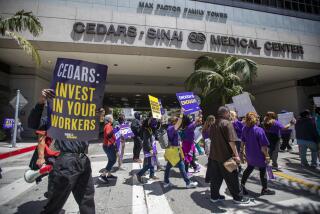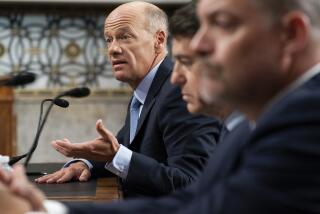Another Nice Option for Executives
- Share via
Who stands to gain when a company’s stock price falls? Top executives, that’s who.
Company stock options--rights to purchase shares of common stock at a set price in the future--are often “repriced” when stock prices slip. That allows executives to buy shares at a cheaper price in the future, benefitting managers at times when public shareholders are savaged.
Consider John Sculley, chairman and chief executive of Apple Computer. Last year, he held options to buy 100,000 Apple shares. But after Iraq invaded Kuwait and share values of nearly all major companies plunged, Sculley’s options became worthless.
Apple allowed employees to turn in these options for new rights to buy company shares at a lower price. The net result: Sculley’s options are now worth more than $1 million. (The lower the price at which options can be exercised, the more valuable the options.)
David A. Bossen, president and chief executive of Cupertino, Calif.-based Measurex Corp., also got to turn in old options for new ones allowing him to buy shares at a lower price. At today’s market prices, his options are worth about $300,000 more than they were just a few months ago.
And these examples are by no means unique. Dozens of companies--including Caesars World, 3Com Corp., Bank of San Francisco, Advanced Micro Devices, Digital Microwave and Diceon Electronics--lowered the exercise prices on their options so that executives wouldn’t lose when their companies’ share prices fell.
Although the trend was more sweeping this year than normal, repricing stock options isn’t new. Indeed, some companies reprice their options so frequently it has the look of an unsuccessful white sale.
Vitalink Communications Corp. in Fremont, Calif., for example, cut the exercise price on executive stock options in August, 1988; December, 1989; April, 1990, and again in September, 1990. In the end, average exercise prices were cut in half.
Genus Inc. of Santa Clara, Calif., also started lowering exercise prices on its options nearly three years ago, and they now can be used to buy stock at $1.25 per share, down from $8.
Corporations maintain that these option replacement and repricing programs are needed to give executives more incentives to make the company’s market value grow. But many critics believe that the plans simply give executives rewards for poor or lackluster performance.
“You have just increased their compensation for declining performance,” complained Graef Crystal, a UC Berkeley professor and compensation expert. “That makes absolutely no sense.”
Then too stock options were supposed to make managers think like owners. That was supposed to benefit shareholders because managers would have a vested interest in getting share prices to rise.
But when options are repriced without any cost to the executives, consultants question whether they actually serve the intended purpose.
“The rationale given is that what hurt the stock was an external market factor out of the control of the executives,” said Gary C. Hourihan, president of Strategic Compensation Consultants. “The problem is, they don’t raise option (exercise) prices when there’s a bull market that runs up the price of mediocre performing companies.”






